
 When fixing sunken or uneven concrete slabs, homeowners have a few options: repair with polyurethane, repair with mudjacking material, or replace the slab. Both polyurethane and mudjacking material lift and stabilize affected slabs without the need for complete demolition and replacement. However, notable differences exist between these approaches in price, effectiveness, and longevity. The cost of concrete leveling depends on these factors.
When fixing sunken or uneven concrete slabs, homeowners have a few options: repair with polyurethane, repair with mudjacking material, or replace the slab. Both polyurethane and mudjacking material lift and stabilize affected slabs without the need for complete demolition and replacement. However, notable differences exist between these approaches in price, effectiveness, and longevity. The cost of concrete leveling depends on these factors.
Polyurethane Concrete Leveling vs Mudjacking
Polyurethane concrete leveling contractors inject a liquid resin beneath the sunken slab. The resin expands into a foam, solidifies the soil, and lifts the slab. As a result, polyurethane forms a strong bond with the concrete underside, creating a durable support base that prevents future erosion.
On the other hand, mudjacking contractors pump a cement slurry under the sunken slab to push it back up. While the dried cement provides support, it doesn't adhere to the concrete as effectively as polyurethane. Over time, the cement may settle or wash away, requiring repeated applications. Furthermore, mudjacking requires heavier equipment and longer curing times.
Concrete Leveling vs Replacement
The choice between polyurethane leveling and full replacement depends on your slab's condition. Multiple cracked sections across the entire surface may call for replacement. Conversely, isolated sinking of mostly intact slabs may suit lifting better. In general, polyurethane concrete leveling is less invasive and less expensive than complete replacement.
The Cost of Concrete Leveling
When estimating concrete leveling job costs, contractors consider a few key factors:
- Size of the Slab: Larger areas may require more material and labor. In contrast, smaller areas may be more straightforward.
- Extent of the Damage: The level of cracking and sinking determines the most appropriate repair method. Minor issues may suit polyurethane leveling, while extensive damage might require additional repairs or replacement.
- Condition of the Soil: A thorough evaluation of the soil beneath sunken slabs will reveal underlying issues contributing to the problem. These findings help determine the best action for a stable, long-lasting repair.
A professional contractor can provide options and help you make an informed decision. They will find an effective and efficient solution for your specific situation.
Fill out this form or call 404-618-0438 for a contractor referral today!



 Essential Details
Essential Details

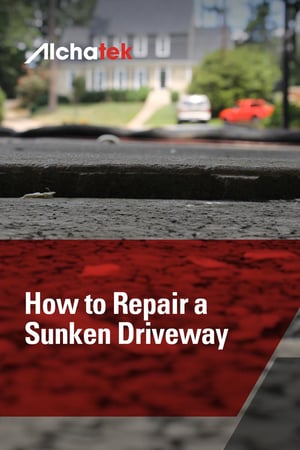 Sunken concrete slabs in your driveway can be a frustrating and unsightly problem. Not only do they detract from your home's curb appeal, but they can also create safety hazards for vehicles and pedestrians. Fortunately, there are effective ways to repair sunken slabs and restore your driveway to its original smooth, level surface. It’s essential to understand how to repair a sunken driveway properly.
Sunken concrete slabs in your driveway can be a frustrating and unsightly problem. Not only do they detract from your home's curb appeal, but they can also create safety hazards for vehicles and pedestrians. Fortunately, there are effective ways to repair sunken slabs and restore your driveway to its original smooth, level surface. It’s essential to understand how to repair a sunken driveway properly.
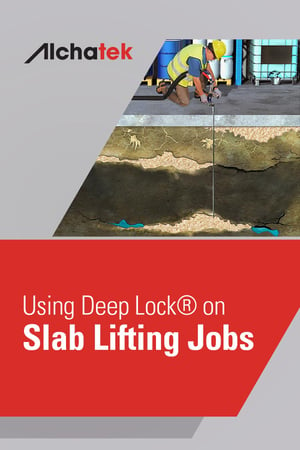 While Alchatek's Deep Lock® process is primarily used on deep soil stabilization jobs, there are specific situations in which deep soil stabilization may be needed to reinforce soil on slab lifting jobs. In cases where slabs are bearing heavy loads, have significantly loose soil underneath, or are located in areas where access is limited, incorporating the Deep Lock® process can help address the underlying soil stability issues. With the addition of the Deep Lock® soil stabilization process, contractors can achieve effective, minimally invasive slab lifting results while simultaneously improving the long-term stability of the foundation.
While Alchatek's Deep Lock® process is primarily used on deep soil stabilization jobs, there are specific situations in which deep soil stabilization may be needed to reinforce soil on slab lifting jobs. In cases where slabs are bearing heavy loads, have significantly loose soil underneath, or are located in areas where access is limited, incorporating the Deep Lock® process can help address the underlying soil stability issues. With the addition of the Deep Lock® soil stabilization process, contractors can achieve effective, minimally invasive slab lifting results while simultaneously improving the long-term stability of the foundation.

 Essential Details
Essential Details
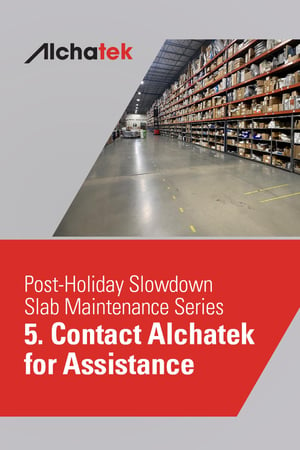 Alchatek, with its expertise in commercial property maintenance, stands ready to provide comprehensive support in addressing your concrete slab needs.
Alchatek, with its expertise in commercial property maintenance, stands ready to provide comprehensive support in addressing your concrete slab needs.
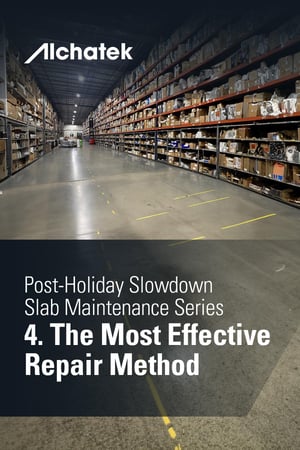 After identifying issues with concrete slabs in your commercial property, the next step is choosing the right repair method. The post-holiday slowdown offers the perfect timing for such repairs, and understanding the available solutions is key to making an informed decision.
After identifying issues with concrete slabs in your commercial property, the next step is choosing the right repair method. The post-holiday slowdown offers the perfect timing for such repairs, and understanding the available solutions is key to making an informed decision.
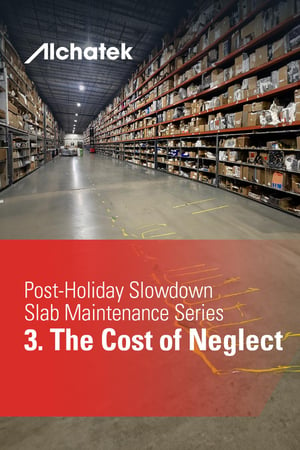 After a bustling holiday season, commercial properties may be left with more than just the usual wear and tear. One critical but often overlooked aftermath is the potential damage to concrete slabs. One thing is certain, ignoring the problem is a lot more expensive than doing something about it.
After a bustling holiday season, commercial properties may be left with more than just the usual wear and tear. One critical but often overlooked aftermath is the potential damage to concrete slabs. One thing is certain, ignoring the problem is a lot more expensive than doing something about it.
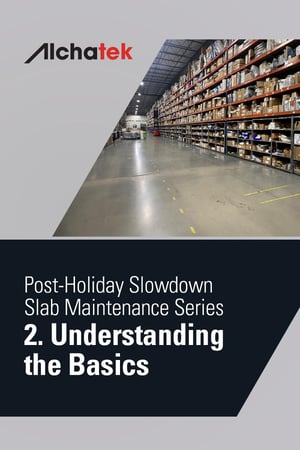 Concrete slabs are essential in providing a stable base for flooring in warehouses, retail showrooms, and other commercial spaces. However, despite their durability, concrete slabs are not immune to problems. Over time, they can become unlevel due to various factors like soil settlement and heavy loads.
Concrete slabs are essential in providing a stable base for flooring in warehouses, retail showrooms, and other commercial spaces. However, despite their durability, concrete slabs are not immune to problems. Over time, they can become unlevel due to various factors like soil settlement and heavy loads.
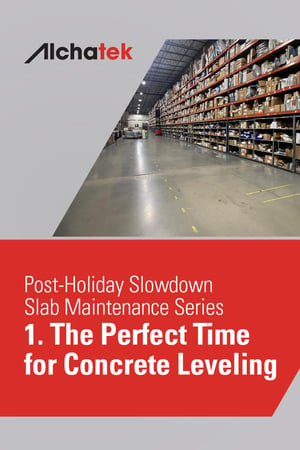 As the holiday season winds down and the festive decorations are packed away, commercial property owners and managers find themselves in a unique period of the year – the post-holiday slowdown. This quieter time offers an ideal opportunity for essential maintenance tasks, particularly addressing one of the most common yet overlooked issues: unlevel concrete slabs.
As the holiday season winds down and the festive decorations are packed away, commercial property owners and managers find themselves in a unique period of the year – the post-holiday slowdown. This quieter time offers an ideal opportunity for essential maintenance tasks, particularly addressing one of the most common yet overlooked issues: unlevel concrete slabs.